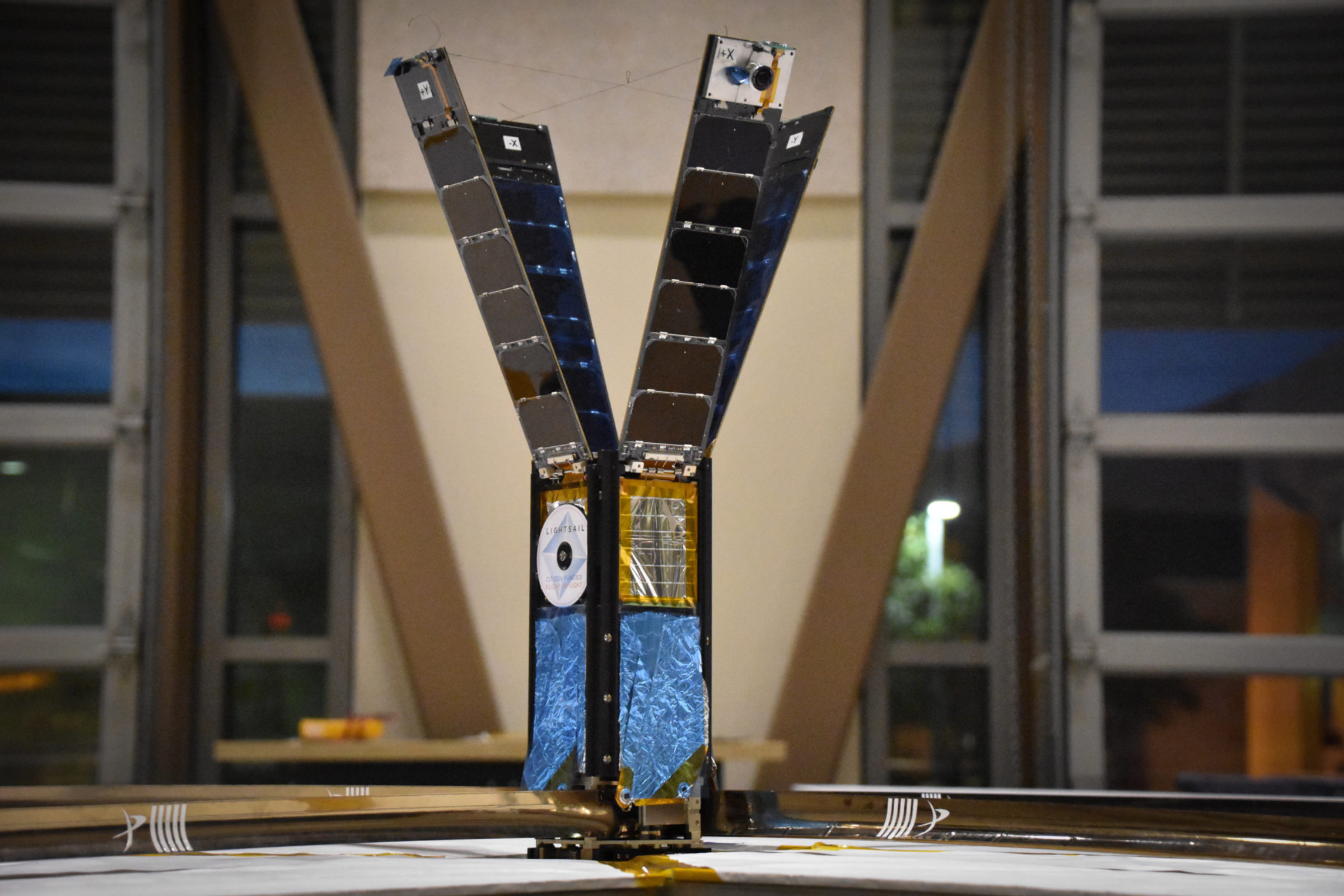Jason Davis • Dec 06, 2016
Ground finale? Deployment test moves LightSail 2 closer to handoff
The Planetary Society's LightSail 2 spacecraft completed what may have been its final end-to-end systems test today here at Cal Poly San Luis Obispo. All of the CubeSat's critical functions were tested, in what was effectively a repeat of May's "day-in-the-life" test—without the spacecraft's Mylar sails attached to their deployment booms.
"We test to find problems on the ground so we don't first discover them in space," said Bruce Betts, the director of science and technology projects for The Planetary Society. "Today, we were able to validate improvements and updates that have been made since our last test in May."

More images from LightSail's ground finale
Can't get enough LightSail pretty pictures? We've got you covered. Check out our Flickr album to see more photos from Tuesday's test.
LightSail 2 is nearly ready to be integrated with its P-POD, the spring-loaded box that will carry it to space. After integration takes place, the loaded P-POD will be shipped to the Air Force Research Laboratory in Albuquerque, New Mexico. Shipping may occur in January. At AFRL, LightSail's P-POD will be installed inside Prox-1, a Georgia Tech-built SmallSat that will hitch a ride to orbit aboard the second flight of SpaceX's new Falcon Heavy rocket.
Because of ongoing delays stemming from the explosion of a Falcon 9 rocket in September, LightSail and Prox-1 are not expected to launch until at least Fall 2017. Engineers have used the extra schedule time to make additional software fixes and minor improvements.
Before handing off LightSail for good, however, the team wanted to conduct another end-to-end test on the space-bound flight unit.
The test began this morning around 10:00 a.m. local time, when the two power-inhibit switches that stay depressed while LightSail is in its P-POD were released. This kicked off the spacecraft's autosequence, a timeline of events that pace the timing of events during the mission. After five minutes, LightSail's antenna deployed as expected:
Antenna deployed! If #LightSail was in space, it would be drifting away from Prox-1 in a 45-minute wait period before transmitting. pic.twitter.com/QuE80D7NAb
— Jason Davis (@jasonrdavis) December 6, 2016
Because LightSail 2 will initially be very close to Prox-1, the autosequence pauses 45 minutes before kicking off regular beacon transmissions. These transmissions contain vital information about the spacecraft's health and status.
Acquisition of signal. #LightSail began sending beacons to Cal Poly station as scheduled. Also transmitting "L-S-2" in morse code. pic.twitter.com/0B0YwrRm2y
— Jason Davis (@jasonrdavis) December 6, 2016
A review of spacecraft telemetry, which was received over-the-air through Cal Poly's ground station, revealed all systems were normal. LightSail's momentum wheel, which swings the spacecraft into and out of the sun's solar photon stream, was successfully spun and stopped. Images were captured, and photo thumbnails were properly downloaded.
Next, LightSail's four solar panels were deployed:
Solar panel deployment! Today's #LightSail test is continuing to go smoothly. pic.twitter.com/YJh5l70cnl
— Jason Davis (@jasonrdavis) December 6, 2016
After a lunch break, LightSail was transported from its clean room to a large engineering bay for the final step of the test: sail boom deployment.
At that point, LightSail lobbed its engineering team a few last minute challenges.
First, the spacecraft refused to deploy its booms, offering up instead a vague timeout error in response. The problem was traced to a ground station software configuration mismatch. After a tweak to a Cal Poly server, the deploy command was resent, and this time, the spacecraft obeyed:
Success! #LightSail deployed its sail booms here at Cal Poly, passing a critical milestone for today's test. pic.twitter.com/iC2Nk75kNM
— Jason Davis (@jasonrdavis) December 6, 2016
As the booms were extending, telemetry data on the motor count appeared to freeze. But after the booms stopped, an updated count was received, lending further evidence to a theory that LightSail's motor causes localized electromagnetic interference. That interference, it is believed, mutes some spacecraft communications.
But since the interference is only temporary, and only occurs during solar sail deployment, it is not expected to impact the mission. Following similar behavior encountered during May's day-in-the-life test, the team implemented a failsafe timer that shuts down the motor after a predetermined interval.
Today's onsite testing team consisted of: Alex Diaz and Stephanie Wong, Ecliptic Enterprises Corporation; Justin Foley and John Bellardo, Cal Poly San Luis Obispo; and Bruce Betts, The Planetary Society. Project manager Dave Spencer joined via Skype.
Let’s Go Beyond The Horizon
Every success in space exploration is the result of the community of space enthusiasts, like you, who believe it is important. You can help usher in the next great era of space exploration with your gift today.
Donate Today

 Explore Worlds
Explore Worlds Find Life
Find Life Defend Earth
Defend Earth


